英语文摘:《穹顶之下》同呼吸共命运
《穹顶之下》观后感作文500字_500字读后感

《丘吉尔的选择》读后感600字_600字读后感今天,我想和大家分享一篇题为《丘吉尔的选择》的文章。
这篇文章侧重于描写人物的心理、神态。
它深深地打动了我,让我深有感触。
《丘吉尔的选择》主要写了英国前首相丘吉尔在母亲即将放弃自己的爱情边际两次鼓励了母亲,使母亲两次走进了婚姻的殿堂。
在自己的仕途和母亲的幸福之中,他心甘心情愿地选择了后者,两次用自己的臂膀给了母亲信心与力量,并温暖了母亲的心。
这篇文章的主人公丘吉尔是一位关爱母亲、无比孝顺的好儿子,他以母爱的幸福为幸福,顶住外界巨大的压力,不顾自己仕途上遇到的困难,毅然捍卫选择了母亲。
他不仅是一个英雄、一个伟人、更是一个会用自己的臂膀温暖母亲心灵的孝顺儿子。
我想,这也是他人生中一笔宝贵的财富,他的心灵也会因此得到升华。
这篇文章虽然不长,但给我们的启示却是深刻的:父母为了我们的成长,付出了许多努力。
他们含辛茹苦只为了将我们培养成人。
但,在他们遇到困难或伤心时,我们是否尽了自己的全力去安慰、帮助他们?父母在事业,生活上遇到不顺时,最需要的莫过于儿女们的体谅与安慰。
有时,我们并不需要像丘吉尔那样做出那么大的牺牲,只要说一句温暖人心的话语,给父母一个结实有力的肩膀,一个温暖的拥抱等,父母就会感动得热泪盈眶。
是呀!父母要求的并不多,一份温暖已足够,但我们却真正给足了这份温暖了吗?父母给予我们的爱像山般沉重,海般辽阔,而我们回报给他们的爱顶多是一条小河、一块石头。
然而,就是这条小河让大山漾起了淙淙的流水声;就是这块石头在大海中激起了千层浪!温暖父母,也点亮了我们的心灵之灯。
这是人生的哲理,也是传递亲情的真谛。
《穹顶之下》观后感作文500字_500字读后感今天,我观看了纪录片《柴静雾霾调查•穹顶之下》,有了非常深的感触,就像柴静说的同呼吸、共命运。
柴静怀孕了,本该是值得全家人开心的事,但是,那个还没出生的孩子被医生诊断为良性肿瘤,孩子一出生就得立刻动手术,手术要全身麻醉,刚出生的孩子可能会撑不住,全家人都为这个还未来到人世间的小宝宝揪着心。
穹顶之下环境营造论文

穹顶之下环境营造论文摘要:当你听到一个六岁小女孩告诉你,她从没有见过纯粹的蓝天,不知道白色的云朵是什么样子?那是一种什么样的心情,又是一种什么样的悲哀。
朋友们,是我们醒悟的时候了,这并不只是柴静与雾霾的一场“私人恩怨”,是我们每一个深受其害的普通人都必须参与的一场斗争。
让我们睁开探索真相的双眼,动起手来,在享受我们权利的同时,也履行起我们的义务,承担起我们的责任,还我们的父母、孩子、和后代一片清澈的蓝天,一个健康的生活环境。
牢记,苍穹之下的蓝,需要我们共同携手!前两天和朋友聊天,说起想写一篇关于雾霾的小文章,唤醒社会中个体的责任感,:面对雾霾,我们能做些什么。
朋友一听马上就笑了,说,这个话题已经不新鲜了,大家都知道,况且网上一大堆,要你重申吗?我马上反驳道:太原也算是雾霾的重阵之地,你也每天上下班,被埋没在雾霾之中,你为此做了些什么呢?他马上沉默了。
也许他在默默想:雾霾之下的又不止你一个人。
“雾霾之下的又不止我一个人”,这可能是每个人都持有的想法。
正是这样的想法,让人类与雾霾之间的战斗,仅仅成了国家、政府和企业的事。
在当今中国这个复杂多元的社会中,我们大多数人基本上每天都是为生存而努力,而奋斗。
社会是以一个大熔炉的姿态展现在我们面前等待我们融入,在这样的社会化过程中,我们不断见识着新的事物,接受着新的信息,同时也在想用着这些新变化。
这是个不可缺少的过程,让我们看到了竞争,感到了冷酷,变得麻痹。
很多人睁着双眼却不愿去探求真相,张开双耳却拒绝声音,迈开步伐却只为自己的私利。
每个人都在喧嚣,每个人都在说话,却没有人去认真听用心做。
这是一种及其矛盾扭曲的放大心理,人们厌恶冷漠,却拒绝温暖。
回顾我们国家坎坷的历史,我们打败过嚣张的帝国主义,打败过残忍的法西斯主义者,打破过苏美的核垄断,我们向月球挑战,向太空挑战,可是在雾霾问题上,很多人却推行了“鸵鸟政策”,一副把自己武装好了,就事不关己的态度。
这些天,正值柴静推出自费拍摄的雾霾深度调查《穹顶之下》,这部片子是辞职之后的柴静,以一位母亲的身份,从保护自己孩子的角度出发,向社会发起的铿锵有力的呼吁,但是否掷地有声,是需要我们每个普通人去证明的。
Under the Dome穹顶之下
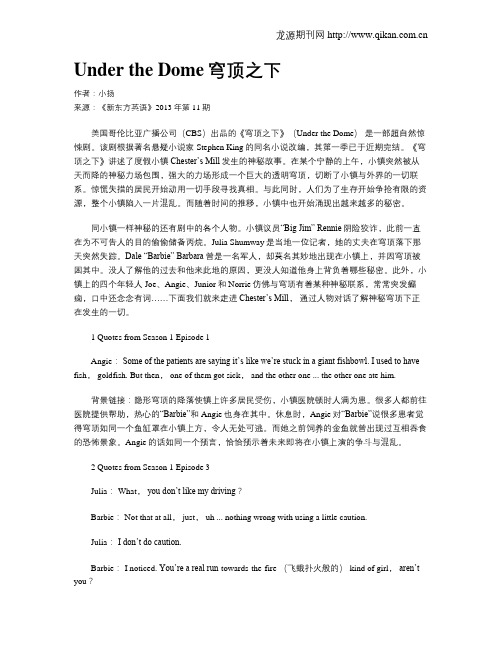
Under the Dome穹顶之下作者:小扬来源:《新东方英语》2013年第11期美国哥伦比亚广播公司(CBS)出品的《穹顶之下》(Under the Dome)是一部超自然惊悚剧。
该剧根据著名悬疑小说家Stephen King的同名小说改编,其第一季已于近期完结。
《穹顶之下》讲述了度假小镇Chester’s Mill发生的神秘故事。
在某个宁静的上午,小镇突然被从天而降的神秘力场包围,强大的力场形成一个巨大的透明穹顶,切断了小镇与外界的一切联系。
惊慌失措的居民开始动用一切手段寻找真相。
与此同时,人们为了生存开始争抢有限的资源,整个小镇陷入一片混乱。
而随着时间的推移,小镇中也开始涌现出越来越多的秘密。
同小镇一样神秘的还有剧中的各个人物。
小镇议员“Big Jim” Rennie阴险狡诈,此前一直在为不可告人的目的偷偷储备丙烷。
Julia Shumway是当地一位记者,她的丈夫在穹顶落下那天突然失踪。
Dale “Barbie” Barbara曾是一名军人,却莫名其妙地出现在小镇上,并因穹顶被困其中。
没人了解他的过去和他来此地的原因,更没人知道他身上背负着哪些秘密。
此外,小镇上的四个年轻人Joe、Angie、Junior和Norrie仿佛与穹顶有着某种神秘联系,常常突发癫痫,口中还念念有词……下面我们就来走进Chester’s Mill,通过人物对话了解神秘穹顶下正在发生的一切。
1 Quotes from Season 1 Episode 1Angie:Some of the patients are saying it’s like we’re stuck in a giant fishbowl. I used to have fish, goldfish. But then, one of them got sick, and the other one ... the other one ate him.背景链接:隐形穹顶的降落使镇上许多居民受伤,小镇医院顿时人满为患。
国旗下的讲话之穹顶之下,同呼吸共命运
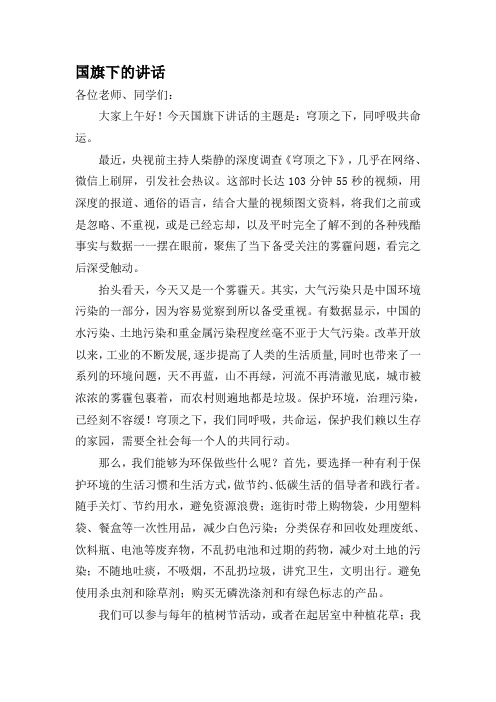
国旗下的讲话各位老师、同学们:大家上午好!今天国旗下讲话的主题是:穹顶之下,同呼吸共命运。
最近,央视前主持人柴静的深度调查《穹顶之下》,几乎在网络、微信上刷屏,引发社会热议。
这部时长达103分钟55秒的视频,用深度的报道、通俗的语言,结合大量的视频图文资料,将我们之前或是忽略、不重视,或是已经忘却,以及平时完全了解不到的各种残酷事实与数据一一摆在眼前,聚焦了当下备受关注的雾霾问题,看完之后深受触动。
抬头看天,今天又是一个雾霾天。
其实,大气污染只是中国环境污染的一部分,因为容易觉察到所以备受重视。
有数据显示,中国的水污染、土地污染和重金属污染程度丝毫不亚于大气污染。
改革开放以来,工业的不断发展,逐步提高了人类的生活质量,同时也带来了一系列的环境问题,天不再蓝,山不再绿,河流不再清澈见底,城市被浓浓的雾霾包裹着,而农村则遍地都是垃圾。
保护环境,治理污染,已经刻不容缓!穹顶之下,我们同呼吸,共命运,保护我们赖以生存的家园,需要全社会每一个人的共同行动。
那么,我们能够为环保做些什么呢?首先,要选择一种有利于保护环境的生活习惯和生活方式,做节约、低碳生活的倡导者和践行者。
随手关灯、节约用水,避免资源浪费;逛街时带上购物袋,少用塑料袋、餐盒等一次性用品,减少白色污染;分类保存和回收处理废纸、饮料瓶、电池等废弃物,不乱扔电池和过期的药物,减少对土地的污染;不随地吐痰,不吸烟,不乱扔垃圾,讲究卫生,文明出行。
避免使用杀虫剂和除草剂;购买无磷洗涤剂和有绿色标志的产品。
我们可以参与每年的植树节活动,或者在起居室中种植花草;我们还可以做一名环保志愿者,积极宣传低碳生活和环保意识,监督举报破坏、污染环境的行为。
最后,引用《穹顶之下》视频中一句发人深省的话语:“最愚昧的事,是容忍自己处于愚昧之中;最麻木的事,是容忍自己处于麻木之中”。
为了大家的美丽家园,我们每个人都要从我做起,积极行动起来,注重节能环保,成为一名合格的绿色环保卫士。
《穹顶之下》第二季(英语学习)
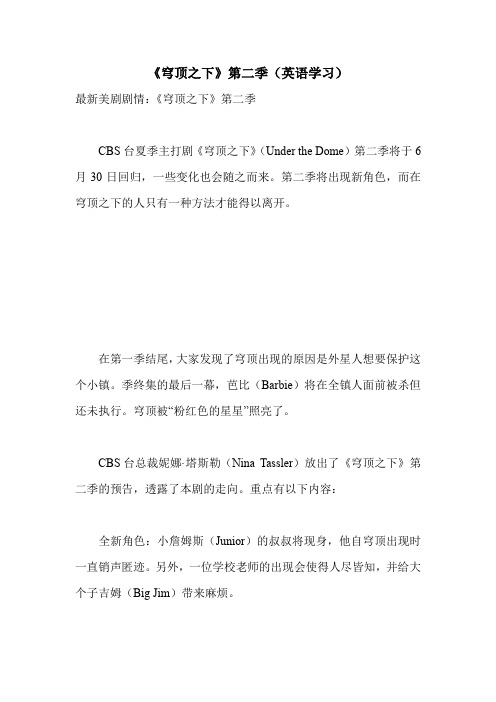
《穹顶之下》第二季(英语学习)
最新美剧剧情:《穹顶之下》第二季
CBS台夏季主打剧《穹顶之下》(Under the Dome)第二季将于6月30日回归,一些变化也会随之而来。
第二季将出现新角色,而在穹顶之下的人只有一种方法才能得以离开。
在第一季结尾,大家发现了穹顶出现的原因是外星人想要保护这个小镇。
季终集的最后一幕,芭比(Barbie)将在全镇人面前被杀但还未执行。
穹顶被“粉红色的星星”照亮了。
CBS台总裁妮娜·塔斯勒(Nina Tassler)放出了《穹顶之下》第二季的预告,透露了本剧的走向。
重点有以下内容:
全新角色:小詹姆斯(Junior)的叔叔将现身,他自穹顶出现时一直销声匿迹。
另外,一位学校老师的出现会使得人尽皆知,并给大个子吉姆(Big Jim)带来麻烦。
意外浪漫:在预告片里,大个子吉姆和琳达(Linda)警长在相拥接吻。
我去!
早领便当:两个“最喜爱”的角色在首播集会被杀。
抛开书本:第二季将会到达原著中未及的处境。
你认为谁会在首播集被杀?现在可以下注了!谁的死会让你伤心?
《穹顶之下》第二季于6月30日(周一)美国东部时间晚10点首播。
柴静《穹顶之下》雾霾英文怎么说

柴静的《穹顶之下》说的是她和雾霾的私人恩怨,更是我们大众关心之至的健康和环境问题。
想要了解雾霾,想要唤起国内外对环境污染的重视度,想要为环保出一份力,先从学好雾霾的英文表达开始吧!在网上,雾霾的英文通常有以下3种:smoke,haze以及smog。
究竟哪种说法最准确?这就要从雾霾的成分说起了。
《穹顶之下》告诉我们,雾霾是PM2.5等可吸入颗粒物悬浮在空中形成的。
它的来源主要是煤炭燃烧、汽车尾气和光化学污染。
Haze A slight obscuration of the lower atmosphere, typically caused by fine suspended particles.Haze虽然可以译作烟雾,但它的本意是指空气中的蒸汽、微粒形成的雾气,并不特指污染物。
Smoke A visible suspension of carbon or other particles in air, typically one emitted from a burning substance.Smoke是指燃烧释放的微粒形成的烟。
雾都人民看不见河北省的火焰,而且光污染和汽车尾气也制造了一大批PM2.5。
因此唐山人民可以管钢铁厂排出烟叫smoke,帝都魔都的雾霾却应该换一种说法:smog。
Smog Fog or haze intensified by smoke or other atmospheric pollutants.因为没有现成的单词准确形容雾霾,英国人在20世纪初用smoke和fog合成了一个新单词smog,专指空气污染形成的雾霾。
《穹顶之下》里提到的英国1952年污染事件的学名就叫做great smog of ’52。
更多英语学习方法:企业英语培训/。
《穹顶之下》----呼吸同一片天
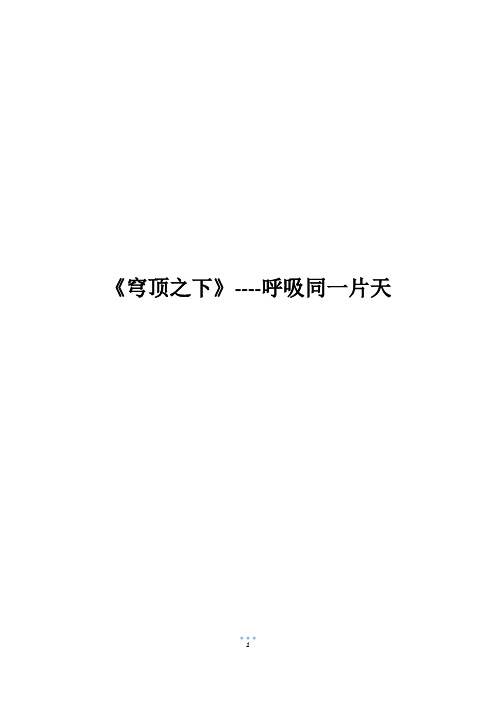
《穹顶之下》----呼吸同一片天众所周知,柴静《穹顶之下》几乎是一夜之间成了新闻的热点,微信、微博及整个朋友圈都被《穹顶之下》刷了满屏,柴静用103分钟详解了雾霾的来源、雾霾的危害,以及雾霾已存在的时间,因为她的力量、震撼和冲击,更因他的题材引起了轩然大波,今天我们共同走进雾霾对呼吸疾病的极大危害!1961年,日本由于石油冶炼和工业燃油产生的废气,严重污染大气,引起居民呼吸道疾病骤增,尤其是哮喘病的发病率大大提高。
1964年日本连续3天浓雾不散,严重的哮喘病患者开始死亡。
到1965年11.78%的哮喘病人在雾霾的折磨中死去。
1952年12月,伦敦一场史无前例的超级“杀人毒雾”直接导致1.2万多市民死于非命(其中主要是儿童、老人和各种呼吸病患者),此后的几十年中,伦敦仍时不时地遭到雾霾的侵袭。
伦敦人在对付雾霾的漫漫征途中,为缓解、减轻雾霾对身体的毒害,积累了不少实战经验。
雾霾天对呼吸系统影响大,这已成为多数人的共识。
雾霾的主要成分是PM2.5,人类肉眼是看不见它的,雾霾产生的细颗粒物会影响呼吸系统增加气道炎性反应,增加气道炎性效应,还会进一步影响心血管系统,而呼吸系统与外界环境接触频繁,且接触面积较大,数百种大气颗粒物能直接进入并黏附在人体上下呼吸道和肺叶中,并且大部分会被人体吸入。
姚主任指出,PM2.5入侵人类呼吸系统时,经过鼻孔、咽喉、下呼吸道等系统,引发各类呼吸系统炎症疾病,到颗粒物进入肺泡后,直接影响肺的通气功能,导致呼吸困难,引发哮喘、肺纤维化、肺癌等严重的慢性肺部疾病。
天曾经蓝过,云曾经白过,我们都曾有过蓝天白云的记忆,但是近一些年,除了仅有的美好记忆,我们似乎一直生活在污染和雾霾之中。
相比其他灾害,来自大气的污染,让我们就像生活在让柴静受到启发的那部科幻片中的切斯特磨坊镇,无论达官贵胄,还是升斗小民,都只能真正的“同呼吸,共命运”。
每个人的头顶上都有一个穹顶,而我们习惯了低头忙碌地过自己的生活,从不抬头仰望一下头顶上那片美的天空。
柴静穹顶之下英文分析演讲技巧之语言篇2
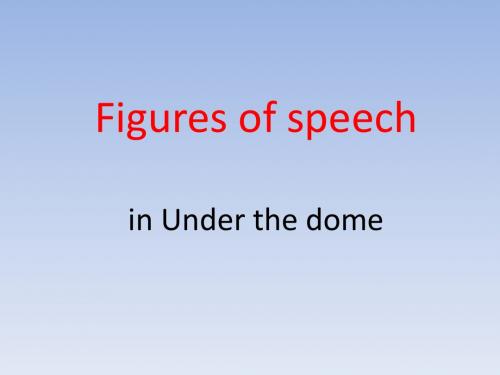
in Under the dome
Simile
It is a figure of speech which makes a comparison betw een two unlike elements having at least one quality or characteristic in common.
Hyperbole
• Hyperbole is the use of exaggeration as a rhetorical device or figure of speech. It may be used to evoke strong feelings or to create a strong impression, but is not meant to be taken literally.
• • • • • • • • • • • • 这是那个采样膜最初的样子,对吗? 谁也听不懂这个数字,对吗? 可是雾霾我们这两年才听说,对吗? 全世界都要烧煤和油,对吗? 就是好煤会烧得越来越少,对吗? 北京的夜里没有车,对吗? 只要你修路就需要跑车,不是吗? 到底是什么物质? 两克黑碳能有多大?能有整个篮球场那么大 这是煤吗?我最初认为这肯定不是煤, 光北京2010年一年我们增加的车是多少呢?八十万。 所有的东西都会呼吸进去,它有多少呢?
• eg.1.那个紫得发白发亮的地方是中国,(黑碳)它像幽灵一 样在我们的上空飘荡. • 2.你在高空往下俯瞰的时候,一千两百万人,就像是被水 泥砌在了底下 • 3.这里有像倒长的大树一样,密布的支持管是我们最好的 滑雪道。 • 4.中石化是大,就像一个人很胖,但是虚胖。 • 5.我们俩就看着这一幕那种心情特别像小孩,看着最后一 颗糖 • 6.它更像一个知了蜕壳的过程,一点一点一点从原有的壳 里面蜕出来
Under the dome

Smog =smoke(烟) + fog (雾) ,源于20世纪的伦敦。
Over the past 30 years , our country’s lung cancer mortality rate was increased by 465% , fine particulate matter clear carcinogenic risk has received more and more attention .State media recently reported that an eight-year-old girl who lived near a busy thorough fare in the coastal province of Jiang Su had been diagnosed with lung cancer . The case of the girl ,believed to be the country’s youngest lung cancer patient has sparked a public outcry.
过去30年内,我国的肺癌死亡率上升了465%,细颗粒物明确致癌风险,越来越 得到重视。据官方媒体近日报道,在沿海的江苏省,一个住在临近繁忙街道 的八岁女孩被诊断出患有肺癌,这个女孩据说是中国最年轻的肺癌患者,这 件事已经引发舆论哗然。
→这是雾霾中的 北京。
这是柴静e ,how bad our living environment. “under the dome” , we breathe together in all destiny .So it is our obligation to prove that a planet that is illuminated by energy can still be clean and healthy.
同呼吸,共命运——《穹顶之下》你需要了解的十条常识

同呼吸,共命运——《穹顶之下》你需要了解的十条常识近日,柴静自费拍摄的公益纪录片——雾霾深度调查《穹顶之下》引发了各大媒体和网友的广泛关注。
通过纪录片,柴静回答了我们三个问题:“雾霾是什么?它从哪儿来?我们该怎么办?”以下十条常识来自该视频,你需要了解的。
1、雾霾是什么?成分很复杂,有15种致癌物:硫酸盐、硝酸盐、铵盐、有机物、矿尘、无机碳、其他金属元素。
它们可以碰撞、组合、反应,一起向你攻击:影响呼吸系统,造成肺癌;影响心血管系统、降低心脏供血能力,甚至引发心梗,以及各种过早死亡。
因为颗粒太小,鼻毛、喉毛都挡不住,会吸进内脏,造成呼吸道、心血管疾病。
2、雾霾会造成什么伤害?雾霾严重的地区,很多人不抽烟也得肺癌,甚至婴幼儿也得了肺炎。
因为没有流行病学调查,医生只能诊断为不明原因肺炎。
过去30年,中国肺癌死亡率飙升了465%,前卫生部长陈竺指出,中国每年因大气污染过早死亡50万人。
3、为什么10年前雾霾的事没这么热闹?虽然2012年第一次开始正式增加pm2.5监测,但其实污染已经从十年前就开始了,10年前的人们还以为雾霾只是雾而已,之后随着对PM2.5的读数关注,人们终于发现了问题的严重性。
4、雾霾从哪儿来?燃煤、燃油、生物质燃烧(比如烧柴火、秸秆)、工业生产、养殖、化肥使用和扬尘,其中60%来自对化学能源的燃烧(燃煤和燃油),几乎全部的来源都和人类生产生活有关。
5、雾霾这么重,该怪谁?疯狂烧煤却产能严重过剩赚不到钱的钢铁企业;凌晨PM2.5峰值时进出大城市的假国III、国IV标柴油大货车;本来可以骑车走路却一点路也一定要开车的市民;烧散煤取暖的市民和烧褐煤供暖的供暖单位;你家附近土堆没有做遮挡工作的工地……在中国,柴油含硫量超国际标准25倍;汽油油品则长期比发达国家低两到三个等级,达标油不超过3%。
如果国内供应的汽油整体提高一个等级,排放可以降低10%,但意味着增加500亿元的成本。
6、为什么凌晨都睡觉了,没有车还雾霾爆表?凌晨的PM2.5通常达到一天风之,比当天下午高出两倍。
穹顶之下,你我同呼吸共命运

穹顶之下,你我同呼吸共命运作者:黄腾霄来源:《中学课程辅导·教师教育(中)》2016年第12期【摘要】穹顶之下,你我同呼吸共命运。
唯有你我并肩携手,我们才能在慈祥的笑脸——天空下奔跑,在温暖的摇篮——草原上休息,在爱的源泉——地球里沐浴,继续在这颗蓝色星球上快乐幸福地仰望星空。
【关键词】环境保护问题呼吸【中图分类号】 G622.4 【文献标识码】 A 【文章编号】 1992-7711(2016)12-195-01在坦桑尼亚的一个小村庄,一个小小的井口旁排起了长长的队伍。
队伍的最前端,一个小姑娘双脚撑住井壁,正在舀取浑浊的井水。
排了十个小时的队以后才轮到她取水,而且还得继续等井里渗出足够的水才能舀取,也就是说,下一位还要再等将近一个小时才能取到水。
高楼林立的都市里,清晨,PM2.5化身成散不去的“浓雾”,肆意地穿梭在城市的每一个角落。
白茫茫的世界里时不时发出汽车的鸣笛声和机动车发动的声音。
那声音由远及近,仿佛有很多很多,只是它们都被淹没在了雾霾之下,淹没在了这“化不开的雾”里。
《裸露的村庄》描述着:因乱砍滥伐而被大自然惩罚了的山庄死寂一般,树桩越来越多,植被剧减,泥石流、沙尘暴、山体滑坡等自然灾害接踵而至。
地球在沉重地呼吸,人们在焦灼中叹息……多么令人心痛的画面呀!然而这些都只是环境问题的冰山一角。
这让我不禁想起了柴静的纪录片《柴静雾霾调查:穹顶之下》里,柴静问一个从小就住在化工厂附近的小女孩,“你见过蓝天吗?”“没有。
”“那你想见吗?”“想!”小女孩的脸上充满着童真,而听见这话的我却充满了无奈。
我庆幸生活的小城是中国西南长江边上一个不起眼的小城,是没有被工业生产大肆污染的“蛮荒之地”,这里的空气还没有被污染到出门必须戴口罩的地步,可以轻松喝到干净的水,但我不知道我的子孙,能不能像我一样,放心地大口呼吸,惬意地大口饮水。
我知道,环境保护问题非常复杂,涉及到相关法律制度的完善,国人素质的提高和环保意识的增强等方面。
纪录片《穹顶之下》观后感范文 柴静穹顶之下观后感
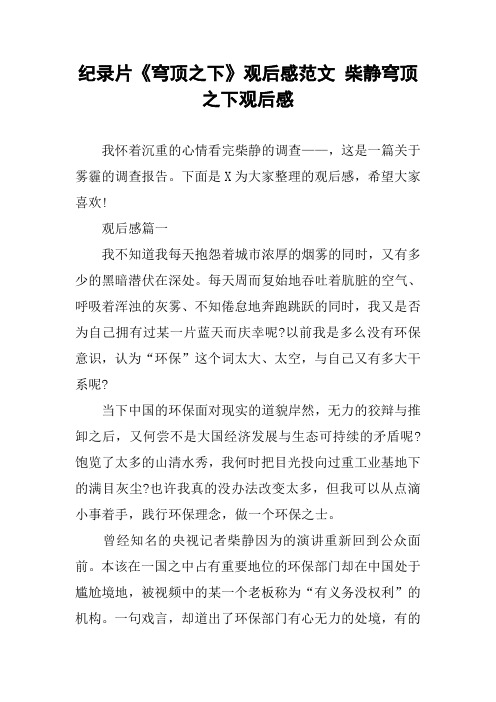
纪录片《穹顶之下》观后感范文柴静穹顶之下观后感我怀着沉重的心情看完柴静的调查——,这是一篇关于雾霾的调查报告。
下面是X为大家整理的观后感,希望大家喜欢!观后感篇一我不知道我每天抱怨着城市浓厚的烟雾的同时,又有多少的黑暗潜伏在深处。
每天周而复始地吞吐着肮脏的空气、呼吸着浑浊的灰雾、不知倦怠地奔跑跳跃的同时,我又是否为自己拥有过某一片蓝天而庆幸呢?以前我是多么没有环保意识,认为“环保”这个词太大、太空,与自己又有多大干系呢?当下中国的环保面对现实的道貌岸然,无力的狡辩与推卸之后,又何尝不是大国经济发展与生态可持续的矛盾呢?饱览了太多的山清水秀,我何时把目光投向过重工业基地下的满目灰尘?也许我真的没办法改变太多,但我可以从点滴小事着手,践行环保理念,做一个环保之士。
曾经知名的央视记者柴静因为的演讲重新回到公众面前。
本该在一国之中占有重要地位的环保部门却在中国处于尴尬境地,被视频中的某一个老板称为“有义务没权利”的机构。
一句戏言,却道出了环保部门有心无力的处境,有的人甚至打出了“经济与环保不可兼得”的旗帜,然而事实呢?这是一个引人深思的话题。
柴静为了孩子,为了一家人,为了这个愈加恶劣的社会环境站了出来。
我们为什么不站出来加入这一场利人利己的环保活动中呢?茫茫宇宙之中,可只有一个地球啊!观后感篇二我怀着沉重的心情看完柴静的调查——,这是一篇关于雾霾的调查报告。
其中,柴静运用了大量的数据进行客观分析,这些数据真实可感,令人十分震撼,心中也很不是滋味。
十年前的我还是个孩子,对未来满怀期待的孩子。
或许你们和我一样,住着破旧的房子,和邻居的孩子在长满荒草的地里玩耍。
每当暮色降临,借助微弱的灯光,轻拨云帘,我们能看到挂满星斗的苍穹,黑暗中隐匿着清晰与神秘。
而十年后的今天,事物的发展速度之快让人难以想象,虽然国人的思想已然有了很大的进步,但高耸的烟囱仍然提醒着我们——我们正在被自己的所作所为一点点吞噬。
眼下的中国和世界上的一些国家一样,正遭受着严重的环境问题。
真实的中国:《穹顶之下》柴静演讲稿全文

真实的中国:《穹顶之下》柴静演讲稿全文柴静演讲稿全文观看柴静在 TEDxBeijing 的演讲,令人深省。
她所描述的中国,正是我们身处其中的中国,一个与外界有着巨大差异的中国。
演讲中,柴静回忆起自己成年后才踏入现实世界的经历。
她说:“当我走出校门,走到城市街头,看到的与我在校园里学习的完全不一样。
我上学的时候,我所了解的是一个庞大的国家,有蓝天、大海、高山和平原。
然而,当我走到城市街头,我看到了什么?我看到了雾霾、污染和交通拥堵。
”她所描述的情景,应该是很多身处中国的人所共有的经历。
众所周知,环境问题是中国的一大棘手问题。
从严重的雾霾到污染的水源、土地,再到不断上升的癌症率和儿童贫血率,都反映出这个国家的环境问题已经到了极为严重的程度。
然而,在这个问题面前,我们该做些什么?演讲中,柴静指出,其实我们的环境问题并不是缺乏解决方案,而是缺乏推动力。
没有足够的推动力,我们无法将环境问题转化为具体可行的政策和措施。
我们需要有足够的热情和追求,才能让这个问题引起我们的关注。
我们需要更多人关注这个问题,才能有更多的力量来推动解决方案的实施。
同时,她也讲到了一些具体的问题,比如盲目追求GDP目标,以及对能源的过度依赖。
她指出,这些是导致环境问题日益严重的根源,而不是简单的污染治理不力。
我们需要在政策制定和理念引导上做出改变,才能坚定地走出环保这条路。
这些看似平凡的思考,却让她成为了一个关注中国环境问题的人。
她用自己的言行,带动了更多人对环境问题的关注,并饱含感情地推动环境问题的解决。
她用自己的行动,展现出了一个真实的中国。
我想引用柴静在演讲中所说的一句话:“我们活在这个国家,这个国家也活在我们身上。
我不想某一天,我们变成了这些污染的根源。
我们需要做的是,从这个问题的源头开始,为我们的未来付出更多的努力。
”这句话是对我们每个人的号召。
我们需要换位思考,关心自己所生活的环境,从而引导政策制定者正视环保问题。
只有这样,我们才能建立一个更加美好的未来。
柴静关于雾霾的演讲:雾霾之上,穹顶之下,我们同呼吸共命运

柴静关于雾霾的演讲:雾霾之上,穹顶之下,我们同呼吸共命运雾霾之上,穹顶之下,我们同呼吸共命运。
尊敬的各位领导、各位嘉宾,亲爱的观众们:大家好!我是柴静。
很荣幸今天能够站在这里,为大家分享关于雾霾的演讲。
雾霾,不只是一个词,它已经深深地渗透到我们生活的点点滴滴中。
当我们开始关注它的时候,才发现它已经成为了我们呼吸的一部分。
正是因为我们同呼吸共命运,所以我们必须对雾霾的存在负起责任。
雾霾,让我们的天空变得灰蒙蒙的,空气中弥漫着让人窒息的颗粒物。
它并不仅仅是一种自然现象,而是人类活动的副产品。
不合理的工业发展,过度的汽车尾气排放,以及燃煤等能源消耗,都是雾霾的罪魁祸首。
然而,无辜的百姓们,尤其是孩子们,却成为了这一切的牺牲品。
不久前,我曾拍摄了一部记录片《穹顶之下》,其中就记录了我对雾霾的深入调查。
我亲眼目睹了当地人民因为雾霾而生活在恐慌中的种种场面。
我记得有一次,我在一个雾霾爆发的城市里,看到了一些小孩在户外进行体育活动。
他们的脸上,穿着,甚至被在地上跑动的灰尘包裹着。
他们的眼神透露着对未来的忧虑,对健康的担忧。
这一幕让我痛心,也让我决心要呼吁大家一起行动起来,改变这个状况。
在我调查的过程中,我也发现了一些希望。
一些城市和企业已经开始采取行动,通过减少污染排放、推广清洁能源等方式来治理雾霾。
同时,很多民间组织和个人也在努力呼吁大家共同关注环境问题。
他们用自己的力量推动着社会的改变。
我们同呼吸共命运,这不只是一个口号,更是一种责任感。
每一个人都应该认识到,保护环境关系到我们每一个人的健康和幸福。
只有每一个人都从自己做起,从身边的小事做起,才能让我们的生活环境更加美好。
在这里,我呼吁各级政府加大力度,制定更加严格的环境保护法规,加强对污染企业的监管。
同时,我也呼吁每一个人都参与到环保行动中来,从自己做起,减少对环境的污染。
雾霾之上,穹顶之下,我们同呼吸共命运。
让我们携起手来,共同努力,为我们的子孙后代留下一个更加美好的明天。
穹顶之下 同呼吸共命运
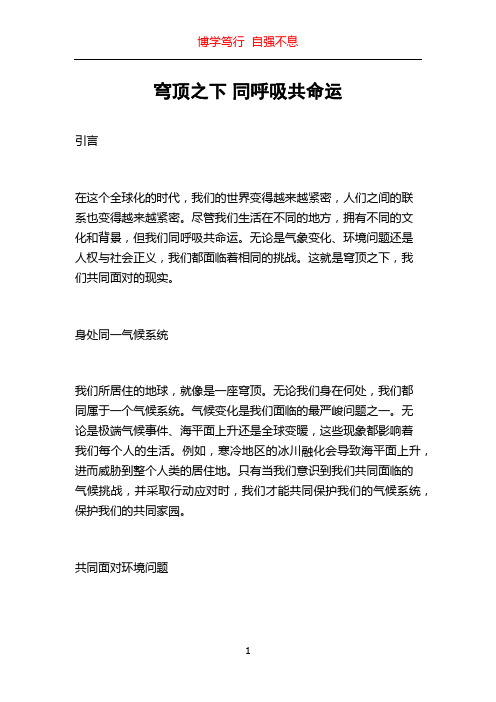
穹顶之下同呼吸共命运引言在这个全球化的时代,我们的世界变得越来越紧密,人们之间的联系也变得越来越紧密。
尽管我们生活在不同的地方,拥有不同的文化和背景,但我们同呼吸共命运。
无论是气象变化、环境问题还是人权与社会正义,我们都面临着相同的挑战。
这就是穹顶之下,我们共同面对的现实。
身处同一气候系统我们所居住的地球,就像是一座穹顶。
无论我们身在何处,我们都同属于一个气候系统。
气候变化是我们面临的最严峻问题之一。
无论是极端气候事件、海平面上升还是全球变暖,这些现象都影响着我们每个人的生活。
例如,寒冷地区的冰川融化会导致海平面上升,进而威胁到整个人类的居住地。
只有当我们意识到我们共同面临的气候挑战,并采取行动应对时,我们才能共同保护我们的气候系统,保护我们的共同家园。
共同面对环境问题环境问题也是我们共同面对的挑战之一。
无论是空气污染、水源污染还是土壤退化,这些问题都无视国界地域,对全球人类都带来威胁。
我们的行为和决策不仅仅影响着我们自己,也影响着其他地区的人们。
例如,一个国家的水资源过度开采会导致其他地区的水源紧缺,影响到那些无法触及的人们的生活。
我们需要意识到我们共享地球资源,共同努力保护我们的环境,确保可持续发展。
人权与社会正义的共同任务在我们共同的家园中,人权和社会正义也是我们共同关注的问题。
无论是贫困、种族歧视还是性别不平等,这些问题都困扰着我们每个人。
当我们看到他人面临不公平待遇或受到歧视时,我们不能袖手旁观。
我们需要团结起来,为所有人争取平等的待遇和公正的社会。
我们的命运紧密相连,我们每个人都应该为建立一个公平正义的社会而努力。
共同应对全球挑战的行动面对这些共同的挑战,我们不能无动于衷。
我们需要采取行动,共同努力解决问题。
以下是我们可以采取的一些行动措施:1. 促进多边合作:政府、国际组织和民间社会可以加强合作,制定共同的政策和行动计划,共同应对全球挑战。
2. 提高意识:通过教育和宣传,增强公众对全球挑战的意识,激发人们的行动力。
柴静《穹顶之下》观后感

柴静《穹顶之下》观后感柴静《穹顶之下》观后感春节上班第一周,柴静以纪录片《穹顶之下——同呼吸,共命运》刷爆各路视频网站、朋友圈、微博等等,掀起了新一轮的媒体事件,引来各路大神围观。
对于雾霾的关注,其实在中国不算是什么特别新鲜的事情了,但是能够一次性地引起如此巨大的媒体聚焦,不得不说是第一次。
柴静的视频播出后,赞扬者有之,论点不相上下,无非是肯定其对于知识普及的功效,认为这部纪录片不仅思路清楚,论点清晰,材料充实,而且以一种女性母亲的身份涉入,具有一种特别亲切的人文情怀,非常容易能够引起广大观众的共鸣,其播出之后引起的巨大效应就是作品本身就是其艺术魅力的最好证明。
只不过,对于《穹顶之下》的批评者所切入的角度却各有不同。
有的直接从新闻本身的客观性出发,觉得柴静本身“TED”式的纪录片并不符合新闻客观性的原则,用婴儿肿瘤与采访小孩子是否看到蓝天等方式纯属于一种无谓的“女性煽情”,很容易给观众造成误导。
而其对于数据的引用,对于诸多概念的表述,对于专家学者的访谈,也诸有段长聚一,移花接木,自相矛盾自处。
还有人从柴静《穹顶之下》所表现出的立场批评其内在的利益链条,比如说对于油气私有的支持,其实完全忽略了中国大型发展电站的正确性等等,必定与私有利益集团的支持有关,不过是为两会的召开提前打个预防针而已。
更有甚者,将攻击直接转移到柴静本人身上,觉得她的女儿得了肿瘤与柴静本身是个“资深烟民”“高龄产妇”密切相关,而她的女儿本身为美利坚合众国的居民,更是将柴静本身口口声声的所谓对于雾霾的关怀大大地打了一个嘴巴。
看了各路神仙对于柴静《穹顶之下》的褒扬和贬低,我都觉得,那些争论比柴静的纪录片本身更有看头了,就像豆瓣上的许多影评比电影本省更加精彩一样。
无可否认,柴静的纪录片给普通大众上了一堂生动的雾霾课,她所运用的多种表达方式所产生的影响力,无疑是那些过分科学的读物所无法取代的。
只不过,那终究只是一堂课而已,所提出的具体建议能不能应用到现实生活中,还是得打一个问号。
同呼吸共命运——穹顶之下观后感-作文

同呼吸共命运——《穹顶之下》观后感每时每刻,我都身处在穹顶之下,我呼吸着空气,却不知道它早已致命,我看这个天空,却不知道它早已不是蓝色,我生活着,却不知道处处都是看不见的危机。
每一口空气都有毒,每一次呼吸都在冒险。
看了《穹顶之下》我才知道,原来我身边全都是不可预知的危险。
空气中,弥漫着肉眼不可见的颗粒物。
相信大家都很熟悉它,它是最近的一个热门话题。
它是一种致命的颗粒物,在人类呼吸时进入人的身体,甚至能引发死亡。
但这仅仅是一个开始,环境污染,大气污染,已经产生了越来越多的致命物质。
而这些致命物质,没有人可以挡住它们的脚步。
中国排放的有毒气体和致癌物质已经达到了非常高的境界,在经济飞速发展的同时,环境问题也变得越来越重要。
很多环境保护的法则,如同摆设一般,从颁发到快要结束时,所运用的次数都是。
我们身边的环境越来越糟糕,已经到了危害我们的生命。
如果说雾霾是一个警告的话,那么接下来的,就是自然的惩罚了。
我看到《穹顶之下》的时候,才明白,原来环境已经变得这样的不堪入目了。
生产一吨钢的利润,甚至连一个茶叶蛋也买不到。
但却又多少人为了这茶叶蛋的钱,不惜去毁坏环境,去危害生命?中国是一个飞速发展的国家,它所需要的,是庞大的经济支援,而在钱后面,却是环境。
钱和环境,真的只能去选一个吗?我相信,中国的脚步是不可阻挡的,经济也是不可以抑制的,但我们,却可以让环境在经济的基础上变得更好。
看了《穹顶之下》,我感受到的并不单单是雾霾的危险,而是整个环境的危险。
如果不将这些化学物质控制住,那么我们面临的将是——灾难。
也许雾霾仅仅是一个开端,未来还有更多的事情将会发生。
但是,我们却可以为环境做一些微不足道的事情,虽然只是一点点,但就是从这么一点点开始,环境将会变得越来越好。
穹顶之下,天已经变得灰白,但只要去努力的做好环保,终有一天,天空回变得蔚蓝。
薛维怡。
实用英语文摘:柴静——同呼吸共命运

实用英语文摘:柴静——同呼吸共命运下面是店铺整理的实用英语文摘:柴静——同呼吸共命运,欢迎大家阅读!柴静——同呼吸共命运Without any previous notice, a documentary dominated headlines and social websites over the weekend.没有一点毫无征兆,上周的头条和热门网站就被一部纪录片刷了屏。
Under the Dome, a 103-minute documentary self-funded by former news anchor Chai Jing, was released on video-sharing websites in China on Feb 28. It has rapidly pushed the public awareness about air pollution and encouraged people to join in efforts to make a difference.这部103分钟的纪录片名为《穹顶之下》,于2月28日登上中国各大视频网站,它是由前央视新闻调查记者柴静自费拍摄制作。
影片一经发布就迅速引起公众对于空气污染的关注,也鼓励了人们要有所行动。
Chai, 39, said she started the work out of her “personal clashes” with smog after she gave birth to a daughter. “I s ealed tight all the windows. I started every day by checking the air pollution index,” Chai said. Millions of other people are also doing the same. While they stop there, Chai goes deeper. “I don’t want to live in this way. I need to find out where the smo g comes from and what on earth is going on.”今年39岁的柴静在女儿出生后开始着手拍摄此片,称其为一个母亲和雾霾的“私人恩怨”。
同呼吸,共命运

同呼吸,共命运--法学1402团支部2015年的新年网上出现了两部纪录片,一部是《超级中国》,而另一部是《穹顶之下》。
同样是引起巨大反响的纪录片,《超级中国》尽是夸耀中国今年的辉煌成就,而《穹顶之下》却把我们从梦中拉回了现实,让我们不得不正视现在的环境问题。
可以说《穹顶之下》犹如当头一棒敲在我们每个中国人的美好的梦境上。
《穹顶之下》经典台词:1:说实话我不是多怕死,我是不想这么活。
2:但就是一个人知道了自己做的一点点事情,可以让事情本身变得更好,他心里面就能够踏实了。
所以回头来看人类与污染的之间战争,历史就是这样创造的,就是千千万万个普通人,有一天他们会说不,我不满意,我不想等待,也不再推诿,我要站出来做一点什么,我要做的事情,就在此时,就在此刻,就在此地,就是此身。
3:不要等问题出来后再去挽回。
我们生活在同一片天空下,雾霾已经成为每个人必须应对并亟需解决的问题!远离雾霾,呼吸同一片纯净天空!”4:每次在夜空中,看到这颗星球孤独旋转,我心中都会有一种难以名状的依恋和亲切。
将来有一天,我会离开这个世界,但是我的孩子还在其中生活,这个世界就与我有关,所以我才凝视它,就像我凝视你,所以我才守护它,就像我守护你。
5:每个人的头顶上都有一个穹顶,而我们习惯了低头忙碌地过自己的生活,从不抬头仰望一下头顶上那片最美的天空。
但其实,只要我们抬头就会看到它的变化,只要伸手,似乎就能离它更近一点,只要众人联手,似乎就能触摸到它了。
这个世界与我们有关,未来的世界也与我们息息相关。
6:我们不可能改变自然条件,我们只能改变我们自己。
正值中国“两会”,环境问题得到了比以前更加多的关注。
但是我们只是关注就可以了吗?日益严重的环境问题已经把你我连成一体,正如柴静所说,我们彼此同呼吸共命运!我们不应该把我们的空气交给当权者去取舍,我们应该自己去守护我们的呼吸,守护我们爱的人。
不要再像以前那样毫不在意好吗?我们期待你的参与。
如果我们能自己守好自己,降低自己对环境的压力,那么环境就好了吗?答案是否定的,因为我们需要社会上的其他人也像我们一样。
- 1、下载文档前请自行甄别文档内容的完整性,平台不提供额外的编辑、内容补充、找答案等附加服务。
- 2、"仅部分预览"的文档,不可在线预览部分如存在完整性等问题,可反馈申请退款(可完整预览的文档不适用该条件!)。
- 3、如文档侵犯您的权益,请联系客服反馈,我们会尽快为您处理(人工客服工作时间:9:00-18:30)。
Without any previous notice, a documentary dominated headlines and social websites over the weekend.没有一点毫无征兆,上周的头条和热门网站就被一部纪录片刷了屏。
Under the Dome, a 103-minute documentary self-funded by former news anchor Chai Jing, was released on video-sharing websites in China on Feb 28. It has rapidly pushed the public awareness about air pollution and encouraged people to join in efforts to make a difference.这部103分钟的纪录片名为《穹顶之下》,于2月28日登上中国各大视频网站,它是由前央视新闻调查记者柴静自费拍摄制作。
影片一经发布就迅速引起公众对于空气污染的关注,也鼓励了人们要有所行动。
Chai, 39, said she started the work out of her “personal clashes” with smog aftershe gave birth to a daughter. “I sealed tight all the windows. I started every day by checking the air pollution index,” Chai said. Millions of other people are also doingthe same. While they stop there, Chai goes deeper. “I don‟t want to live in this way.I need to find out where the smog comes from and what on ea rth is going on.”今年39岁的柴静在女儿出生后开始着手拍摄此片,称其为一个母亲和雾霾的“私人恩怨”。
她说:“我把所有的窗户都封起来。
每天起床的第一件事就是查看当天的空气污染指数。
”其实,成千上百万人和她做着同样的事情,只不过他们止步于此,而柴静做了更多,她说,“我不想这样活着。
我想知道这些雾霾到底从哪儿来,到底发生了什么?”Over a year, she investigated polluted sites to find the sources of smog, visited the US and the UK to learn about their anti-pollution experiences, and interviewed officials, scientists and the general public.一年间,她深入污染地区调查雾霾的来源,远赴美国、英国了解治理空气污染的经验;官员、科学家以及普通百姓都出现在她的采访镜头之中。
Chai‟s research reveals that the burning of coal and oil c ontributes to 60 percent of PM2.5 pollutants. She thus questions the country‟s energy consumption habits in the film.柴静调研发现,PM2.5主要来自煤与油的燃烧(占60%)。
于是,她的这部记录片矛头直指我国能源消费习惯。
She then goes on to disclose loopholes in car emissions regulations. Some of the laws have been in place for years, but have never been applied. The film also explains that businesses are pressured not to abide by the laws because violatingthem carries little or no cost, while making changes bumps up costs. The film also points at Chin a‟s petroleum and steel industries as the biggest sources of air pollution.她还指出我国汽车排放法规存在漏洞,一些出台多年的法律法规从未实施。
对商家而言,违反这些法律法规几乎不需付出任何代价,而做出改善却成本高昂。
影片认为,中国的石油、钢铁行业是空气污染的最大来源。
Chai goes on to list the things ordinary people can do to help and sums everything up by calling for individual responsibility in reporting illegal emissions via the hotline 12369.柴静随后还列出了普通人能够做些什么,呼吁人人都负起责任,比如拨打热线12369举报非法排放。
The film has provoked national discussion after going viral online. Gruesome pictures of withered trees, murky skies, and babies under treatment have moved viewers. But most importantly, the film looks at solutions that the government and individuals can carry out to help.该片在网上走红之后,引起了全国性的讨论。
片中枯萎的树木、灰色的天空、生病的孩童都触动了观众的心弦。
更重要的是,该片还着眼于解决之道,提出政府与个人都可有所作为。
Cheng Chen, a 22-year-old student from Beijing Foreign Studies University, foundthe documentary “very inspiring”.今年22岁的程晨(音译)来自北京外国语大学,她觉得这部纪录片“十分震撼”。
“I used to think it‟s not my duty to deal with air pollution–I don‟t own a factory or a car,” said Cheng. “But Chai told me we share the same fate since we breathe the same air and there is a lot I can do.”她说:“以前我一直认为治理污染并不是自己的责任,因为我既不开工厂,也没有车。
但是,看过柴静的片子之后,我才发现我们不仅同呼吸共命运,而且还能为此做很多事。
”However, some people are annoyed by the film‟s depiction of their polluted hometowns, especially when it shows a banner from Xingtai in Hebei saying “Congratulations to our city for no longer being ranked the last place among thecountry‟s 74 cities in terms of air quality”.当然,也有一些人因为片子对自己家乡污染的描述而感到不适,尤其是在河北邢台拍到的那张横幅,上面写着“为我市退出全国七十四个城市空气质量排名倒数第一而喝彩”。
Such a feeling of “being insulted”, in Cheng‟s eyes, could also be a good thing.程晨却觉得,这样带给人的“冒犯”之感也许并非坏事。
“What‟s important is that Chai‟s work has raised public attention toward the structure of the energy industry,” she said.她说,“柴静片子的意义在于引起公众对于能源行业结构的关注。
”Chen Jining, newly appointed minister of environmental protection, said he had contacted Chai to express his appreciation. “Protecting the environment is never a …personal affair‟ of environmental authorities. We welcome everybody‟s contribution,” Chen told the press on March 1.新任环保部长陈吉宁表示,他已经联系了柴静并表达了感谢。
在3月1日的新闻发布会上,他表示,保护环境从来不是环保部门的‘个人行为’,欢迎人人贡献出自己的一份力。
Meanwhile, experts remind moved viewers of the film‟s limitations.与此同时,一些专家也提醒观众,在被视频感动的同时,也要注意到片子也有其不足之处。
更多英语学习:企业英语/。
